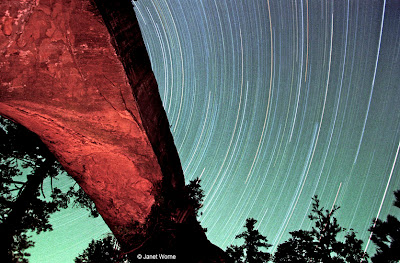 A sandstone arch, millions of years in the making, soars overhead. Countless stars, light-years away, burn trails through the infinite sky. For me, this photograph is about the immenseness of the universe and the passage of time. Both of which make me feel small and yet it is oddly comforting. I find myself wanting to ponder the meaning of life and my place in it. This image takes me back to the creation of the world.
A sandstone arch, millions of years in the making, soars overhead. Countless stars, light-years away, burn trails through the infinite sky. For me, this photograph is about the immenseness of the universe and the passage of time. Both of which make me feel small and yet it is oddly comforting. I find myself wanting to ponder the meaning of life and my place in it. This image takes me back to the creation of the world.
So it only seems appropriate that I used a basic, non-digital method to achieve it.
This image was the result of a five-hour exposure after days of trial and error. I shot this on fuji-color film, ISO 400, f-stop of 5.6, using an old Canon FTb camera and 35mm lens. I needed a fully manual camera that did not rely on the battery to keep the shutter open for long periods. Here are some tips if you want to try this yourself:
1. Pick a dark, cloudless night with no moon. Any light spillover will ruin the picture. Clouds will reflect and amplify any light—even light from the stars.
2. Find a remote location away from city lights—for the above obvious reasons.
3. You’ll need an interesting foreground. I went to the Red River Gorge in Kentucky. A place like Arches National Park or the Bisti Badlands would work. Even a gnarled old tree with plenty of sky around it works. This is where your creativity shines.
4. Mount your camera on a sturdy tri-pod and position it, paying attention to the composition of your image.
5. When you’re ready, set the camera on Bulb (which keeps the shutter open until you push it again) and hit the shutter release.
6. You may or may not choose to light the foreground. I popped a small strobe several times along the underside of the arch. I used a slight warming filter on the strobe. I wanted it to look campfire-lit.
7. Find a comfortable spot and wait. I set my watch alarm and went to sleep in my car. When the time is up, close the shutter.
8. The first exposure was four hours and the second was five. They both worked but I think the five-hour exposure turned out the best. The third exposure was blown out because of the coming dawn.
--Janet Worne
Janet, very interesting read. I like your reason for doing this the "old fashioned" way. You might want to mention that it is critical to first locate the North Star, since the sky revolves around it. Otherwise, you wouldn't get the full circular motion effect. Beautiful image of the arch.
ReplyDeleteGood point, David. For this photo I was more concerned with the arch, but a really great effect can come by having the North Star front and center with the stars completely circling it.
ReplyDelete